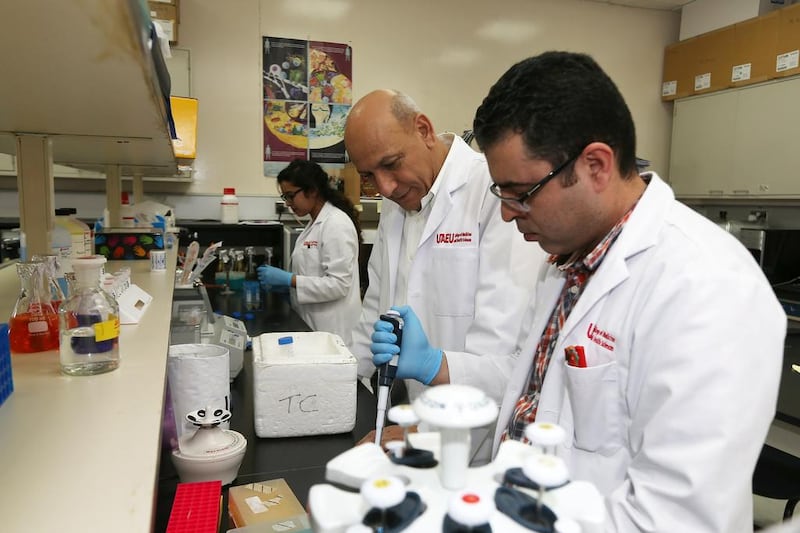Few conditions are more devastating than Parkinson’s disease, a progressive neurodegenerative disorder that is likely to become much more common worldwide as populations age.
It is an incurable condition characterised by shaking, other movement difficulties and, in later stages, dementia. It affects between seven and 10 million people worldwide, with men being one-and-a-half-times more likely to suffer from it than women.
The UAE has played an important part in Parkinson's research, especially in diagnosis. In 2014, The National reported that scientists at UAE University (UAEU) in Al Ain had developed a way to identify the presence of proteins associated with the disorder.
Prof Omar El Agnaf and his fellow researchers created antibodies that can help to detect diseased forms of alpha-synuclein, a protein that in people with Parkinson’s aggregates inside nerve cells in clumps known as Lewy bodies.
The university has licensed San Diego-based BioLegend to produce and sell four types of antibody developed in Al Ain.
Dr Peggy Taylor, BioLegend general manager, says the antibodies can, crucially, detect “intermediate aggregation states” of the proteins, and may potentially offer an early warning of the disease’s development or progression.
With Parkinson’s, the alpha synuclein changes from the normal or native state, which is soluble, to a misfolded state that aggregates.
“If you think of it as a snowball, as it rolls down the hill it gets more snow. Similarly, once the synuclein protein misfolds, it sticks to other synuclein protein molecules, resulting in clumps,” said Dr Taylor.
The shaking and movement difficulty associated to the disease are caused by the death of nerve cells in the substantia nigra, a portion of the brain involved in movement. There is one on each side of the brain.
With Parkinson’s, the nerve cells of this structure produce less of the neurotransmitter dopamine, which controls biochemical pathways associated with movement.
A key problem for clinicians is that most of the nerve cells in the pars compacta, the part of the substantia nigra affected by Parkinson’s, have been destroyed by the time there are visible symptoms in a patient. That means that all that can be done is try to slow the disease’s progression.
“If you can have earlier markers, patients could be identified sooner, before the damage is done in the brain. It will allow interventional treatment before the damage happens and slow the progression,” said Dr Taylor.
Earlier detection could also encourage pharmaceutical firms to focus on developing drugs to combat the disease. The absence of proper diagnostic tools and biomarkers is thought to have discouraged such firms from investing in efforts to find a cure.
“Having these markers available can help with clinical trials to measure how effective a drug is in treating the disease. Does it slow the disease? Does it cure the disease? This is where these items will have a real benefit,” says Dr Taylor.
The antibodies developed by the scientists led by Dr El Agnaf, who has since moved to Hamid bin Khalifa University in Qatar, are “conformation-specific monoclonal antibodies”, because they specifically detect the abnormal form of alpha-synuclein associated with Parkinson’s.
It is thought that, when a person has Parkinson’s, there are changes in the alpha-synuclein found in their cerebrospinal fluid, a liquid that passes through and around the brain and around the spinal cord.
The hope is that, perhaps with the help of the antibodies, tests of the cerebrospinal fluid could become important in diagnosis.
The antibodies could also help in the development of a variety of other diagnostic tests associated with Parkinson’s.
“We believe there will be a high value to the researchers because of the specificity of the antibodies and the ability to distinguish the aggregated forms of the protein from the native state of the protein,” says Dr Taylor.
Having the antibodies licensed commercially through the new agreement allows large amounts to be produced and then supplied reliably to many labs, she says. In this way, a tie-up between the academic world and industry could speed up research.
With licensing agreements, the university can focus on research.
BioLegend will make the four antibodies available commercially − it already has thousands of others in its catalogue − and they could be used, said Dr Taylor, for “multiple research applications”.
The announcement by UAEU that it has signed the licensing agreement with BioLegend comes at an exciting time for research into Parkinson’s.
There are media reports of research findings, such as some recently announced by Leicester University, in the UK, involving fruit flies genetically engineered to develop the disease.
This work has overturned received wisdom by indicating the condition is caused by a fault in the endoplasmic reticulum, a tubular network in cells involved in producing proteins and lipids, and not mitochondria, which generate energy.
The scientists were able to use chemical methods to prevent neurodegeneration, a finding that could ultimately have application in people.
“Parkinson’s disease, in particular, is gaining in resources that are being applied to try to develop new therapeutics and new biomarkers,” says Dr Taylor.
So we can hope that, in the long term, patients may have cause for optimism, and the technology developed at UAEU could play its part in combating this most debilitating of conditions.
newsdesk@thenational.ae






